|
 |
 |
 |
 |
 |
 |
 |
 |
 |
 |
 |
 |
 |
 |
 |
 |
 |
|
|
|
|
|
|
|
|
|
|
|
|
|
|
|
|
 |
|
|
|
|
|
 |
|
|
|
|
|
|
 |
 |
|
|
|
|
|
|
 |
The following account details the historical events leading up to the Clipston School Charity. Who bequeathed it, to whom and for whom.
|
|
 |
 |
|
 |
 |
|
 |
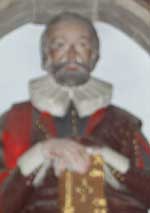 |
|
|
|
|
|
|
|
|
|
 |
 |
|
|
|
|
|
|
|
|
|
 |
 |
|
|
|
|
|
|
|
|
|
 |
Sir George Buswell as seen in Clipston Church |
|
|
|
|
|
 |
 |
|
|
|
|
|
 |
 |
|
|
|
|
|
|
|
|
|
|
|
 |
The following account, until the recent history of the 1970’s, has been entirely taken from the following publication "The story of Clipston Grammar School – Northamptonshire" by Sir Gyles Isham, Bart. - First Published in 1956. Permission to publish has kindly been granted by the present trustees of "Clipston School Charity". |
|
|
|
|
 |
 |
|
|
|
|
 |
 |
|
|
|
|
 |
 |
|
|
|
|
 |
|
|
|
|
|
 |
The Founders Family; Sir George Buswell; The Will; The School Site; The Building of the School; The Love Affair; The Misappropriations; The Anonymous Letter; The Funds.
Please click on one of these subject areas above or work your way through by using the scroll bars.
|
|
|
|
|
 |
 |
|
|
|
|
 |
|
|
|
|
|
|
|
|
|
|
 |
|
|
|
|
Major Historical events in Clipston School Through the Ages.
- 1628 May 17th
- 1660 July 7th
- George Buswell created a Baronet
- 1667/8 March 18th*
- Sir George Buswell makes his Will, making provision for the School and Hospital.
- 1667/8 March 6th*
- Death of Sir George Buswell
- 1673 March
- Building Completed (designed by Matthew Cole)
- 1818
- Charity Estates conveyed to Earl Spencer and 32 Trustees.
- 1844
- The Trustees remove the Master and appoint The Revd. E Bates.
- 1918
- 1926
- Rebuilding of the School and erection of cottages for the former occupants of the Hospital.
- 1965
- Addition of new Hall, Kitchens, Toilets, Classroom and Recreational field.
- 1999 September
- Opened for use a new infant Classroom and mobile Classroom.
-
- *before 1752 the New Year started on March 25th giving rise to some dates having two years e.g. 1667/8, modern reckoning being 1668 for Sir George's death.
|
|
|
|
|
 |
|
How the Founders family became wealthy landowners
John Buswell, who called himself a Yeoman, founded a landed family by sheep-farming and suitable marriages. He was Sir George’s Great Grandfather.
Due to the dissolution of the Monasteries much land was available for purchase and lands from Great Oxendon and Clipston, formally part of the late dissolved Chauntry in Sprotton (presumably Spratton), Northamptonshire, were part of John Buswell’s Will.
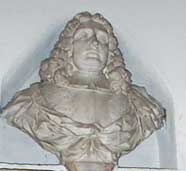 Sir George's father as seen in Clipston Church Sir George's father as seen in Clipston Church
George (Sir George’s, father ) was a child from a second marriage of John, to Mary (nee Botham). His Uncle William Botham – a rich draper with land in Derbyshire and Leicestershire, left legacies to Mary and her children. George being the eldest did rather well and later became an Alderman of the City of London. He then had a child called George - the one we are interested in.
Sir George was nearly six when his father George died in 1632, leaving land in Leicestershire, Northamptonshire and Derbyshire.
Sir George inherited the Northamptonshire lands in Clipston, Haslebech, Kelmarsh, Braybrooke, Great Oxendon, Farndon, Lylborne, and Brixsworth.
Sir George’s mother Elizabeth, (nee Kynnesman) was from a family of higher standing than the Buswells.
She died in 1651, leaving Sir George at 24 years old in the wardship of aristocratic friends of her family.
|
|
 |
|
|
|
|
|
The Man - Sir George Buswell
|
|
|
|
|
|
|
|
|
 |
|
|
|
|
|
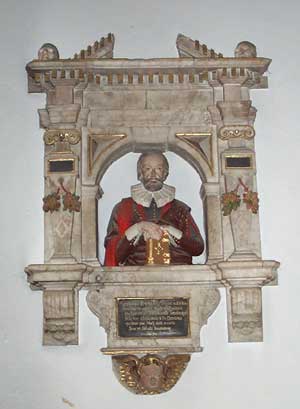 |
|
|
|
|
|
|
|
|
 |
|
|
|
|
|
Picture taken in Clipston Church |
|
|
|
|
|
|
 |
|
Sir George was therefore the recipient of both his father and mother’s wills and a very rich man. He also benefited from his younger brother’s death at 31, and so, acquired his father’s Leicestershire lands.
Sir George was lucky to be too young to take part in the Civil war and so escaped fines that would have otherwise ensued, his Royalist persuasion being shown by his eventual choice of bride, as well as his sister marrying one of Charles Ist courtiers.
Little is known of Sir George himself. His Baronetcy was given by King Charles II, a few months after the Restoration, which may confirm his Royalist standing. However, Sir George was also in a position to be able to pay for this privilege. We do not know which actually happened.
It is known, however, that Sir George served as High Sheriff for Northamptonshire in 1662/3. He also has a child George who died at six months of age.
Sir George made his Will on March 18th 1667 and died March 6th 1668, aged 41 years 9 months.
The Will
Sir George’s Will laid down precise instructions for the foundation and Endowment of a:
"Free Grammar School and an Hospital for the maintenance of a Schoolmaster and the Relief of the Poor to have continuance for Ever".
The Will states "God hath put it into my Heart to bestow some part of my estate, wherewith he hath blessed me, in Works of Charity".
At that time a hospital was a term used to denote an old peoples home. It was common then, for charities to provide for the very young and very old.
He bequeathed for the Charity:
* 8 Trustees and thereafter their Heirs forever.
* Lands in Clipston, Haselbech, and Lilbourne.
* One or more Houses to be erected on Bridge Close, Clipston. To be fitting for the Receipt and Habitation of a schoolmaster, and twelve poor persons and wherein to teach and instruct children.
* A gallery to be erected in the Clipston Church for the Poor People to sit in.
* The children living in the parishes of Clipston, Kelmarsh, Oxendon, Marston Trussell, Haselbech and East Farndon were to be taught free.
* Preference to be given to the Poor of Clipston for the 12 Poor places available.
The Site of the School
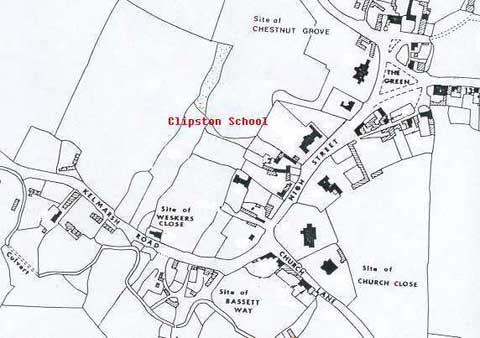
|
|
 |
|
Clipston Village Showing the School - with permission from Peter Wilford, trustee and resident |
|
 |
|
The 8 trustees were all friends and relations of Sir George and lived, in today’s view, fairly locally. However by December 20th 1669 when they had not all met due to distance and pressure of commitments, it was decided that the three closest to Clipston carry out the task, Sir Justinian Isham being the main stay. (The Ishams acted as Trustees for over two hundred years starting with Sir Justinian Isham, 2nd Baronet.)
It was also decided that the site chosen by Sir George, Bridge Close, was too far from the village and danger would be involved in any flood or overflowing of the brook. The site was:
"very inconvenient and unfitting for erecting and building of the said school house and hospital".
Previously in the year a site named "Hall Yard" of two acres near the Church had been sold to the Trustees and this site was exchanged for Bridge Close as a more suitable one.
This is the site of the present day School.
|
|
|
 |
|
The Building of the School
|
|
|
|
|
|
|
 |
|
 |
|
|
|
|
|
|
 |
|
Photo of the elevations of the School exterior as it was in 1925/6 before any alterations. |
|
|
|
|
 |
|
A Matthew Coles, of Clipston, designed and built the School, directed by the Trustee Sir Justinian Isham of Lamport.
Not a lot is known about Matthew Coles except that his Will describes him as a Carpenter. His cottage was left to his wife but it seems from the parish registers that she died "an aged Hospitaller" in 1694, a poor person housed in the building her husband built!
The building is said to be a sound piece of work on traditional lines. Almshouses being a way of keeping a living memorial to their founder.
The architecture is of a usual type whereby the "three gables to the street side give the monumental character".
Sir Isham was a man with considerable knowledge of architecture, from his involvement in his buildings at Lamport. A very suitable man to oversee the School and Hospital, which could have been in a more classical style than this traditional building (of a type since 1620).
|
|
|
|
|
 |
|
|
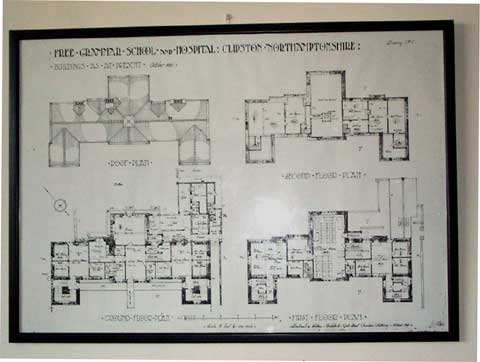 |
|
|
|
|
|
 |
|
|
|
|
|
|
|
 |
|
|
Photo of the plans of the School interior as it was before alteration in 1926
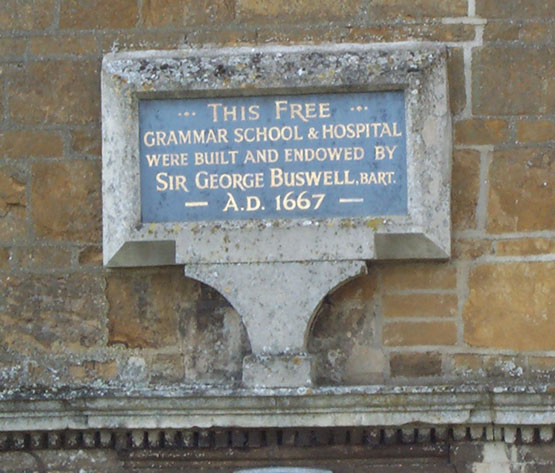
Inscription above the School front entrance |
|
|
|
|
|
 |
|
The Love Affair
Sir Justinian Isham was also the one to propose a marriage between his nephew, a relation of his first wife, and the late Sir George’s widow, as can be seen in this letter below:
"Theese for The Hble Sr. Justinian Isham Baronett att
Lamport humbly present:
Sr, I returne you many thanks for the troble you were pleased to take in veiueing Mathew Coles Draught. I shall take it as a very greate favour if you will come over to Clipston to direct Mathew about the Building the Allmes Howse no person understanding it soe will as your selfe. Sr, my Grandmother acquainted me with the moshion you made for the Gentleman that was with you, in earnest at present I have not any thoughtes of Changeing my condishion, or ellse I should have liked it a great deale the beter bye beeing proposed bye one whom i have soe greate an esteem for, I shall ever aknowlige my selfe infinitly obliged to you, that you are pleased to conserne your selfe for me, I wish i were capable of serveing you and you should find non more readye thern Sr,
Your very humble servant
K. Buswell
May the 18th 1668."
This proposal of Sir Justinian Isham’s is just two months after Sir George’s death, his friend presumable wanting the rich widow to be protected as soon a possible.
After much writing on behalf of Sir Justinian to interested parties the marriage eventually takes place on May 8th 1669. Her suitor John Garrard writes to Sir Justinian in the January of that year:
"Sr, you have sent me to a school of Patience, where I have been pretty severely handled (noe Harme in that) but I have made a shift to conn my lesson indifferent well"
The building of the school and hospital must have continued meanwhile and was finished in 1673.
The couple stayed in the Clipston area until her husband succeeded the Baronetcy and they moved to Hertfordshire. On her death in 1702 she was buried with her first husband in Clipston.
Sir Justinian Isham died in 1675 and his son Thomas took over from his father, as trustee. |
|
|
|
|
 |
|
The Misappropriation of the Trust
Eusebius Buswell (alias Pelsant), Sir George’s Nephew, became heir to the Buswell fortune and took the Buswell name. It seems he disgraced the Buswell name by "shameful abuses…done to this charity".
A letter on 10th June 1712, to Sir Justinian Isham (a successor to the original), from Sir Robert Clarke quotes:
"The Cause of Clipston was heard on the 30th of May, Mr Buswell and his son being present all the time. We treated him wth all manner of civility; and he heard it fully prov’d the most shameful abuses he and others have done to this Charity: and when I sum’d up the Evidence to the Jury ( Wch was long) I asked if I had done it fairly; and both sides said I had omitted nothing yt was proved of either side and done very fairly. ………I don’t remember yt he has done any thing conformable to the Donors Will; But has in an Arbitrary way acted wth out regard to the Rules prescribed. Yet we agreed onely to looke forwards and forgive Faults"
Mr Buswell aged 56 appears to have got off Scot-free!
One of the "shameful abuses" appears to be about 120 acres of land worth £95 per Annum, in Lilbourne, for which the Trust received no benefit at all.
His son mentioned, (another Eusebius) was aged 25 at this time. He also appears to be an uncreditable person, even though he was created a baronetcy. His lands in Staffordshire, Leicestershire, Rutland and Northamptonshire were seized by an Act of Parliament, after his death, for payment of depts. He left no heirs and his second wife’s daughter, Frances Horton (nee Buswell) and her descendants were left to redeem the family honour by increasing the endowments of the School and Hospital by generous legacies.
|
|
|
|
 |
|
The Anonymous Letter – 40 Years On.
An unsigned letter was published in 1714 to several inhabitants of the villages in the catchment area of the trust. This conceded that:
* No proper register book had been kept.
* There had been an enquiry into the "disposal and management of this charity".
* The Trustees had not been seen to do anything about the enquiry.
* There was no procedure to hear complaints, which might justly be made.
The writer then advises the inhabitants to give the Trustees a copy of the Will and to have it turned to the advantage Sir George designed it for. A list of all the present Trustees were then named and a quote of the orders to be done by them in the Trust!
Obviously the court hearing had not been severe enough in its dealings with the Trust funds and things were still amiss
.
|
|
|
|
|
 |
|
The Funds
Eusebius Buswell I’s Era - 120 acres in Lilbourne - £95 (not received)
1770 - 118 acres in Lilbourne, annual rent = £133 8s. 0d.
70 acres in Haslebech annual rent = £56 18s. 0d.
1830* 117 Lilbourne £260
68 Haslebech £100 £688*
1874 £350 688 13s 4d
1918 Land sold and invested in Government Securities
1926 £11,000
*By 1830 Funds accumulated from the legacies left by the Horton family and others amounted to £688.
|
|
 |
|
|
|
 |
 |
|
 |
|
|
|
|
|





 Sir George's father as seen in Clipston Church
Sir George's father as seen in Clipston Church
